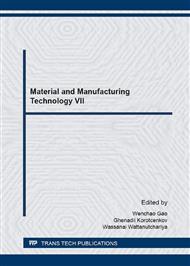p.8
p.13
p.18
p.23
p.28
p.33
p.38
p.45
p.50
Effect of Porosity on Residual Stress of 2024-Aluminum GTAW Specimen
Abstract:
Aluminum alloys are used widely in many applications due to its low in density which can lead to a lightweight product. A high percentage of Cu in the chemical composition of the 2024 aluminum alloys helps withstand the occurrence of corrosion as well. Thus, aluminum alloy grade 2024 is used as a material for several parts in aircraft and spacecraft components, (e.g. the body of commercial airplanes), as well as parts in many other applications. Gas Tungsten Arc Welding (GTAW) is used widely in joining material parts together. Inappropriate welding parameters usually cause problems such as porosity in the welding. The occurrence of porosity is undesirable in welding because it can affect the strength of the welding area as well as other properties. Tensile residual stress near the surface of the material expedites the fatigue crack initiation. The relationship of porosity and residual stress for GTAW parts was very limited in literatures. Therefore, the objective of this research was to investigate the relationship of porosity to the occurrence of residual stress after the welding process. Full factorial design of experimental technique was used for setting up welding conditions of the GTAW. The specimen with highest porosity was selected for further analysis of its effect on residual stress. Porosity was analyzed by the radiographic testing (RT) and the residual stress was measure by X-ray diffraction (XRD) using sin2 method. The results showed that the highest porosity in the welded bead was found at the current of 130 A, the welding speed of 210 mm./min., and the wire feed rate of 700 mm./min. The results also suggested that lower current and welding speed caused an increase in porosity. The residual stress results on both longitude and transverse directions showed tensile residual stress at locations around the welded bead area.
Info:
Periodical:
Pages:
28-32
Citation:
Online since:
September 2016
Authors:
Keywords:
Price:
Сopyright:
© 2016 Trans Tech Publications Ltd. All Rights Reserved
Share:
Citation:


